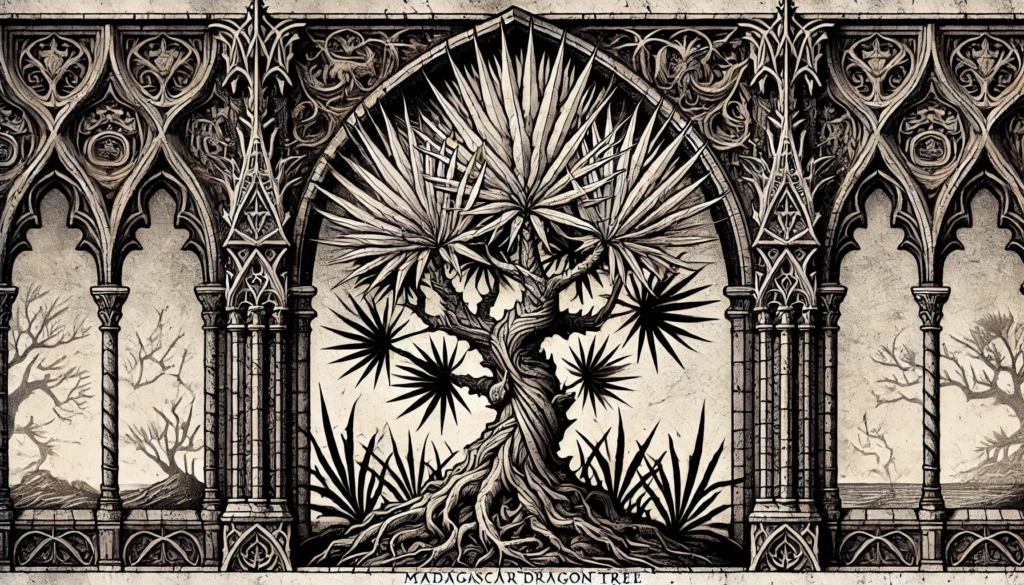

Home » Cat Plants » Is Your Cat at Risk from the Madagascar Dragon Tree Plant?

The Madagascar Dragon Tree (Dracaena marginata) is a popular houseplant known for its striking, slender leaves and low-maintenance care requirements. However, while this plant may be a beautiful addition to your home, it can pose a serious threat to your feline friend. Cats are not allergic to the Madagascar Dragon Tree, but the plant is toxic when ingested.
The Madagascar Dragon Tree contains saponins, which are toxic compounds that can cause a range of symptoms in cats if consumed. This plant is commonly found in households as an ornamental plant and is often placed on shelves or tables where curious cats may be tempted to nibble on the leaves.
Ingestion may cause mild gastrointestinal upset, but is generally not life-threatening.
Ingestion can result in mild symptoms like vomiting, diarrhea, or drooling. Rarely fatal but may require veterinary care.
Eating these plants can lead to more pronounced symptoms like abdominal pain, lethargy, or difficulty breathing. Veterinary intervention may be necessary.
Ingesting even small amounts can cause severe symptoms like organ damage, seizures, or cardiac failure without rapid treatment.
All parts of these plants are extremely poisonous to cats and can quickly lead to death, even with immediate veterinary care.
** Please note: Please note that toxicity level can vary based on the amount ingested and the specific cat. It's always best to keep these plants completely inaccessible to cats and seek immediate veterinary care or call the poison hotline if you suspect your cat has ingested any part of a toxic plant.
If your cat has ingested any part of a Madagascar Dragon Tree, they may experience a range of symptoms due to the toxic saponins present in the plant.Common symptoms of Madagascar Dragon Tree toxicity in cats include:
If you suspect your cat has consumed any part of this plant, it’s crucial to monitor them closely and contact your veterinarian for guidance.
If you bring your cat to the veterinarian with suspected Madagascar Dragon Tree toxicity, they will likely follow these steps to diagnose and treat your feline friend:

A: Yes, the Madagascar Dragon Tree is toxic to cats. Ingesting this plant can cause symptoms such as vomiting, drooling, and lethargy in felines.
A: Common symptoms include vomiting, drooling, dilated pupils, and loss of appetite. If your cat displays any of these signs after ingesting the plant, seek veterinary care immediately.
A: To deter your cat from the Dragon Tree, use natural repellents like citrus peels or install a protective barrier around the plant. Keeping the plant out of your cat’s reach can also help prevent accidental ingestion.
A: If you want to avoid toxic plants, consider cat-friendly options like the Spider Plant or Areca Palm. These alternatives are both non-toxic and visually appealing, making them great choices for homes with pets.
A: The Madagascar Dragon Tree contains saponins, which are moderately toxic to cats. While it may not be as dangerous as some highly toxic plants like Lily, it can still cause significant health issues if ingested by your pet.
A: If your cat ingests part of a Madagascar Dragon Tree, contact your veterinarian immediately. Prompt action is crucial to prevent severe symptoms like vomiting or lethargy from worsening.
The Madagascar Dragon Tree, also known as the Red-Edged Dracaena or Madagascar Dragon Tree, is native to Madagascar, an island nation off the coast of East Africa. This plant has been cultivated for centuries and was introduced to Europe in the late 18th century as an ornamental plant.
In its natural habitat, the Madagascar Dragon Tree can grow up to 20 feet tall, but as a houseplant, it typically reaches heights of 4-6 feet. The plant’s long, slender leaves with red edges give it a distinctive appearance that has made it a popular choice for indoor décor.
Despite its popularity, the Madagascar Dragon Tree has long been recognized as toxic to cats and dogs due to the presence of saponins. As a responsible pet owner, it’s essential to be aware of the potential risks this plant poses to your furry companions and take steps to keep them safe.
Please note: The information shared in this post is for informational purposes only and should not be considered as veterinary medical advice.
🐾 A hilarious or heart-melting cat video
🐾 Our latest paws-on review of a cool cat toy